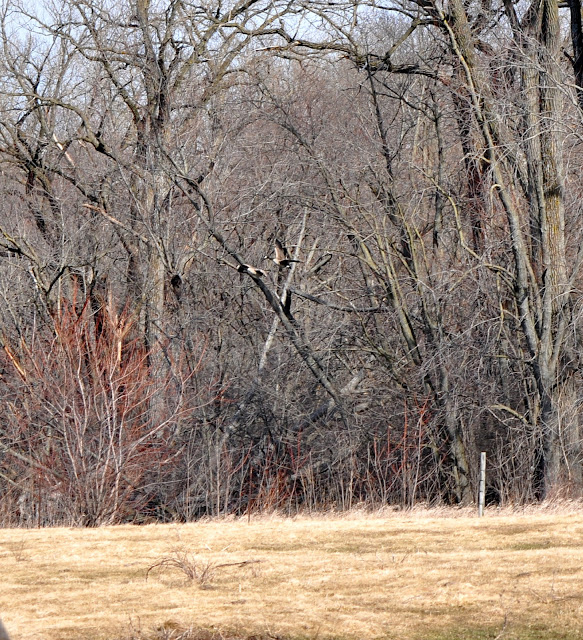IT'S A RED-TAIL!!!!!!!!!

And indeed it was once I was able to ditch the car, scramble out, and get her in focus.
This is the full photograph of the hawk to give you a "feel" for what she might be up to.
 And here we are back to the cropped photo to try and get some characteristics in order to possibly ID her later. She appears to have a medium dark defined belly band, streaks not blotches and a medium dark head with a slightly lighter brow...at least in this light. No missing or broken feathers visible.
And here we are back to the cropped photo to try and get some characteristics in order to possibly ID her later. She appears to have a medium dark defined belly band, streaks not blotches and a medium dark head with a slightly lighter brow...at least in this light. No missing or broken feathers visible. And one more thing, though I have been calling this hawk by feminine pronouns as is traditional, I don't actually know which sex she is. She could well be male for all I know.
Okay, I'll admit it.
I have an automatic bias that I constantly have to keep in mind. Pale Male of New York's Central Park, being particularly pale, has always been much lighter than any of his numerous mates. This was also the case with the original Cathedral Church of St. John the Divine Red-tailed Hawks. The male, Tristan, though not as pale as Pale Male was far lighter colored than Isolde who was a particularly large, beautifully dark feathered hawk with big dark almond shaped eyes. And down at the southern end of the park were sweet Pale Male Jr., and his dark buxom bride, Charlotte. So the three pairs that I watched for many years all fit the pale male and dark female color scheme.
Therefore I have to be careful not to be immediately mentally biased that the paler hawk of any pair is the male. Once you see a pair perched together where you can compare size or are aware who does the lion's share of nest sitting you can be reasonably certain of their gender.
And of course, if you're lucky enough to see them copulating, that's a quick clincher.
Now back to our hawk.....
She appears to be soaring, not much in the way of wing flapping, just gliding on the air currents.
Now she's heading away. Be aware of her wing span and size just in case her mate appears so we can tell them apart. It is that time of year and sky dancing could be imminent.
Do you notice anything unusual? I'm afraid I didn't in the moment and only saw it when I brought up the photograph. Look at the top left corner. What IS that? Possibly her mate flying far higher than she is? Maybe. Though the far bird looks rather "pointy" for a Red-tail. It could be just an optical illusion during a down flap or perhaps...
Is it an Accipiter? The other Red-tail's mate?
Extremely hard to say.
She's actually quite high now. She banks and gives me the eye.
Is she going to turn back? Maybe.  Or is she heading out?
Or is she heading out?I cropped this photo down as I want you to see her wing span. It appears quite wide. This could be a female.
She banks ever so slightly and catches the wind. She's going to be out of here. I can't follow on foot as she's passing over a huge muddy corn field. Not only would I be up to my ankles in muck, I'd be trespassing besides.
I run for the car, get it get it off the verge, turned round, head down the long edge of the field, turn right, do the short end of the field...
Suddenly I find myself staring at a McMansion and I see the hawk disappear into the oaks behind it.
DRAT!
Where is she?
While I'm looking, possibly I should explain what a McMansion is. As you will likely know this is not a typical clapboard or brick farm house. Its all too big in the wrong way, its the wrong era and besides it is surrounded not be silos, barns, machinery and out buildings but rather with things like canoes.....and a cute house for a dog. Farm dogs do not have cute houses. They'd be embarrassed. They work for a living....
TO BE CONTINUED!














































